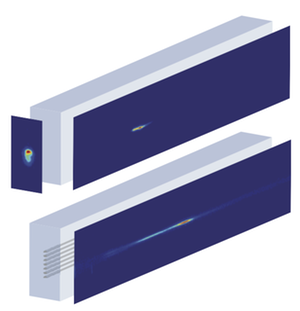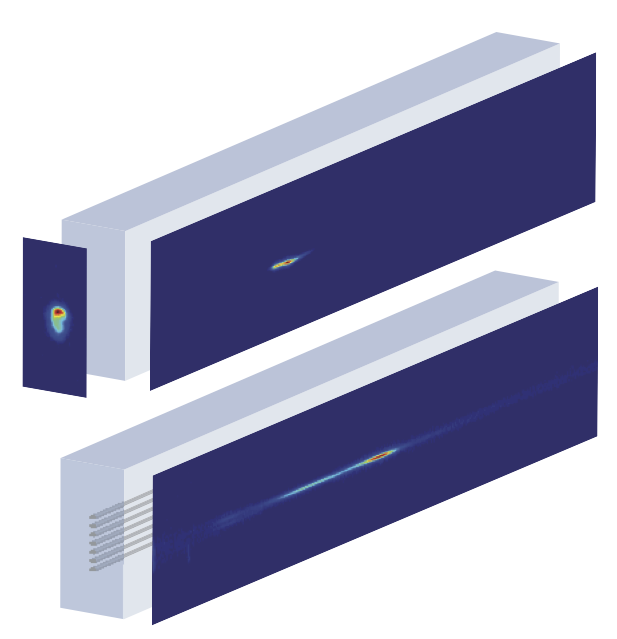Taming Light Filaments
Under the right conditions, an intense laser pulse forms a narrow filament that could zap a remote location with a blast of energy or create a light pulse with unique properties in time or frequency. However, these filaments are hard to control. In Physical Review Letters, researchers show that forming filaments in a piece of glass with a periodic array of material disturbances can stabilize the individual filaments and the interactions between them.
A light beam focused to a tight spot naturally spreads out again, beyond the spot, through diffraction. But if the light is intense enough, it interacts with the medium—air or glass, for example—and raises the index of refraction, especially in the center of the beam, where the light is brightest. This change works like a lens to “self-focus” the beam and balance the spreading effect of diffraction. The beam forms a “spatial soliton” that maintains a constant diameter as it propagates.
When a light pulse is even brighter than that needed to make a soliton, it can focus itself further until it ionizes the air or glass it is passing through, creating a plasma. This intense and narrow beam is called a filament. Its central plasma helps it to avoid a total collapse and to maintain a stable diameter of tens of microns.
“This field is very active, mainly because of applications,” says Stelios Tzortzakis of the Foundation for Research and Technology–Hellas (FORTH) and the University of Crete, both in Heraklion, Greece. For example, the plasma glow from a filament could be used to study the optical signature of a sample that needs to be observed from a safe distance, such as a radioactive or molten material. The interactions between the light and the plasma can also work in the time domain to produce extremely short-duration pulses that remain short as they travel and are useful for observing ultrafast chemistry, for example. Yet another potential application is in producing intense terahertz radiation, which is used in airport scanners.
A critical challenge for these applications is that the complex interactions between the light and the material means that filaments march to their own drummer. The pulses go through cycles, in both time and space, of focusing and defocusing. “This means you don’t have real control,” says Tzortzakis. Previous work by Tzortzakis and his colleagues showed theoretically that the filaments could be stabilized by creating them within a “photonic lattice,” in which the optical properties vary periodically in space . As with a diffraction grating, the lattice would lead to spreading, but it would be controlled by the experimenters and would counter the filament’s sporadic focusing and defocusing, which results from the beam’s internal intensity variations. Tzortzakis and his colleagues have now demonstrated this effect experimentally.
To create the photonic lattice inside a chunk of glass, the researchers used a laser to “burn” long, parallel channels wherein the material was modified enough that its index of refraction was changed slightly. They then sent a -femtosecond laser pulse along the channels. As expected, they found that the extra, controlled spreading induced by the lattice caused the resulting filaments to be more stable and long lasting than in unaltered glass. Tzortzakis says there are also proven ways to write similar patterns in air, for example by creating a temporary pattern of ionization to guide the filaments.
When two filaments are created simultaneously, they can interact, because each one modifies the glass properties in its neighborhood. Sending pairs of filaments through a lattice makes this interaction much more reproducible. The experiments showed that one filament can sacrifice itself to replenish the energy and extend the range of another filament that would otherwise fade out.
Filaments can definitely be “difficult to control,” says Demetrios Christodoulides of the University of Central Florida, in Orlando, who previously used a photonic lattice to control solitons, rather than filaments. He called the use of lattices for filaments a “step forward” toward harnessing these exotic pulses.
–Don Monroe
Don Monroe is a freelance science writer in Murray Hill, New Jersey.
References
- P. Panagiotopoulos, N. K. Efremidis, D. G. Papazoglou, A. Couairon, and S. Tzortzakis, ”Tailoring the Filamentation of Intense Femtosecond Laser Pulses with Periodic Lattices,” Phys. Rev. A 82, 061803 (2010)





